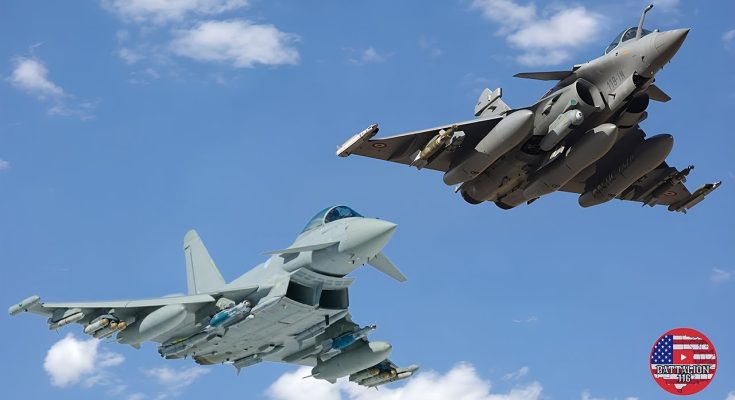The Dassault Rafale and Eurofighter Typhoon are two of the most advanced and capable fighter jets in the world today, each representing the cutting-edge of European aerospace engineering. Both aircraft have been designed to fulfill multi-role missions, excelling in air superiority, ground attack, and reconnaissance, but they each have unique characteristics that set them apart. The debate over the greatness of the Rafale compared to the Typhoon often revolves around their versatility, technology, combat performance, and export success. Let’s explore how these two formidable jets compare and where the Rafale stands out.
Multirole Versatility
One of the defining characteristics of the Dassault Rafale is its multirole versatility. Designed as a true multi-purpose aircraft, the Rafale excels in a wide range of missions, including air-to-air combat, air-to-ground strikes, anti-ship warfare, nuclear deterrence, and intelligence gathering. This flexibility is one of the reasons the Rafale is considered by many to be the more adaptable fighter of the two. The aircraft can seamlessly transition between missions without the need for major modifications, making it a highly versatile asset for air forces and navies.
The Eurofighter Typhoon, while also a highly capable multirole fighter, has been primarily optimized for air superiority. It is an exceptional dogfighter, with superior speed, agility, and a highly capable radar system, making it one of the most effective aircraft in aerial combat. However, the Typhoon’s ability to perform air-to-ground missions is somewhat less versatile than the Rafale’s, despite improvements over time. The Rafale’s design, particularly its integrated weapon systems, gives it an edge in flexibility across a wider range of mission types.
Avionics and Stealth Technology
Both the Rafale and the Typhoon are equipped with advanced avionics, making them formidable opponents in modern combat scenarios. The Rafale features an active electronically scanned array (AESA) radar, highly advanced sensor fusion, and a suite of electronic warfare systems, which combine to give the pilot an unparalleled view of the battlefield. These systems allow the Rafale to detect and engage targets at long ranges, while also evading enemy radar detection. The Rafale’s ability to integrate multiple sources of information in real-time gives it a strategic advantage, particularly in complex combat environments.
The Eurofighter Typhoon is similarly equipped with an AESA radar and boasts an exceptionally high-performance flight control system that enhances its agility in air-to-air combat. Its radar and sensors are particularly effective at tracking and targeting enemy aircraft, making the Typhoon an exceptional fighter in air superiority missions. However, the Rafale’s radar and sensor fusion capabilities are often considered more advanced in terms of providing a more comprehensive, integrated battle picture.
Regarding stealth, the Rafale has some inherent stealth features, such as reduced radar cross-section and radar-absorbing materials, making it harder to detect. While not a pure stealth fighter like the F-22 or F-35, the Rafale’s stealth characteristics give it a significant advantage in contested environments. The Typhoon, by comparison, is designed more for speed and agility than stealth. While it is relatively stealthy in certain configurations, it doesn’t prioritize stealth in the same way that the Rafale does.
Combat Performance and Operational Success
The Rafale has proven itself in multiple combat scenarios, particularly in the Middle East and Africa. It has successfully executed airstrikes in Libya, Syria, and Iraq, among others. Its ability to operate from aircraft carriers adds to its versatility, as it can provide both air force and naval capabilities in a single platform. The Rafale has also been praised for its reliability and maintainability in challenging operational environments, which is critical for long-term use in combat zones.
The Eurofighter Typhoon, while also operational in combat, is primarily air force-based and has participated in missions over Libya and in the Mediterranean. The Typhoon’s primary focus remains air superiority and defense, and it has shown exceptional performance in these roles. However, its air-to-ground capabilities are more limited than the Rafale’s, which has the advantage when it comes to delivering precision strikes in addition to air combat.
Export Success and Global Reach
The Dassault Rafale has proven to be a major success on the international arms market, with significant orders from India, Qatar, Egypt, and the United Arab Emirates (UAE). The Indian Air Force, in particular, placed a large order for 36 Rafales, marking a significant milestone in the Rafale’s export success. Its affordability, combined with its multirole capabilities and strong diplomatic ties with France, has made the Rafale an attractive option for many countries looking to modernize their air forces.
The Eurofighter Typhoon has also seen success in the export market, particularly with countries like Saudi Arabia, Kuwait, Oman, and Qatar. While it has a strong presence in Europe, its export success has been more limited compared to the Rafale, especially in non-European markets. The Rafale’s combination of multirole capabilities and cost-effectiveness has made it an appealing choice for countries with diverse defense needs.
Conclusion: Which is Greater?
The question of whether the Dassault Rafale is superior to the Eurofighter Typhoon largely depends on the specific needs of the air force or nation in question. The Rafale excels in multirole versatility, combat readiness, and cost-effectiveness, making it the more flexible option for nations seeking a fighter capable of performing a wide range of missions. It has a proven record in combat operations, as well as a strong export track record.
The Typhoon, on the other hand, is an exceptional air superiority fighter with superior maneuverability and speed, making it an ideal choice for countries focused on achieving air dominance. It remains one of the most formidable fighter jets in aerial combat, although it doesn’t match the Rafale in multirole flexibility.
Ultimately, both aircraft are formidable, but the Rafale‘s versatility and proven track record give it a slight edge in terms of overall greatness, particularly for countries seeking an adaptable fighter that can perform a wide range of missions effectively.



